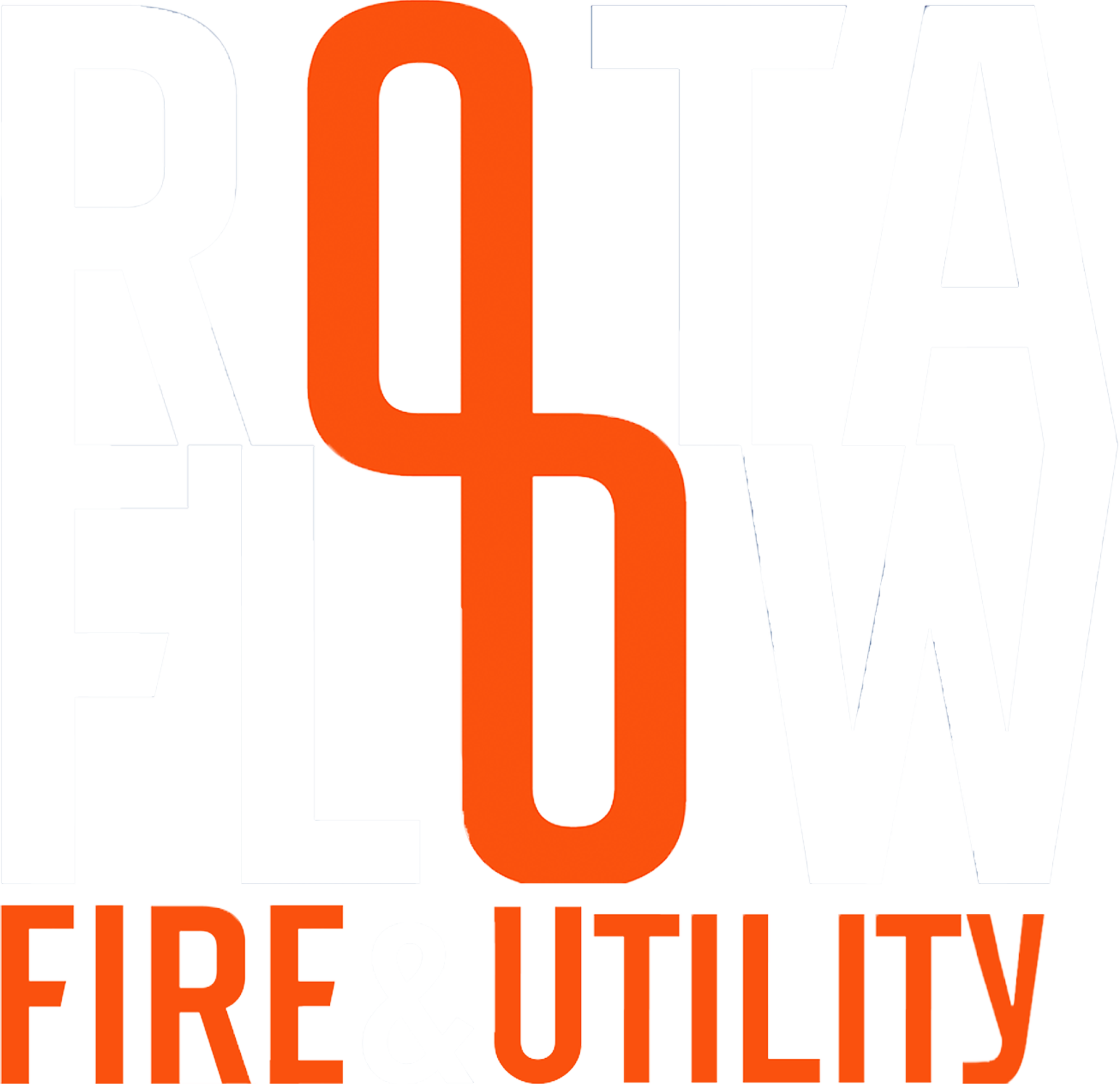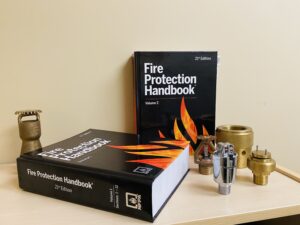The alphabet soup of fire protection acronyms includes several others in addition to ESFR. However, “early-suppression, fast-response” sprinklers are a particularly effective strategy for securing high-risk buildings. ESFR sprinklers, in contrast to many other sprinkler designs, are intended to directly combat the fire rather than merely control it. ESFR sprinkler obstruction rules are specific based on the discharge pattern, type of suppression/control, and hazards protected. Section 14.2.11.3.1(2) indicates additional sprinklers are not required where the obstruction is 1 12 inches or less in width and located a minimum of 12 inches below the elevation of the sprinkler deflector.
Question #1 – Return Bends with a Raw Water Source
The 2013 edition of NFPA 13 requires sprinklers that are supplied from a raw water source be installed with a return bend connected to the top of the branch line. The system in question has a branch line that is elevated above the cross main on a riser nipple. Is a return bend directly to the sprinkler head required if the entire line rises from the main?
Answer- Unless one of the following requirements is satisfied, return bends attached to the top of the branch lines are necessary if pendent sprinklers are supplied with raw water:
- A deluge system is a system.
- Use of dry pendent sprinklers
- Pendent sprinklers in the wet system have a K-factor of 11.2 or higher.
Additionally, when employing vertical or sidewall sprinklers, return bends are not necessary.
The purpose of this requirement, which can be found in NFPA 13’s 8.15.19.1 for the year 2013 edition, is to stop silt from the raw water supply from congealing in the pendant sprinkler orifice or drop nipples.
A variety of sediments may be present in raw water sources (such as an open pond, open top reservoir, lakes, streams, etc. – see A.3.3.19). Simply elevating the branch line above the cross main (with a riser nipple, for example) would not eliminate the need for the return curve since these sediments may be entrained in the water.
The AHJ may accept a strainer in place of the return bend arrangement as authorized by Section 1.5 of NFPA 13, even if it does not comply with the prescriptive requirements of the standard. If accepted, strainers must be listed for use in fire protection, which adds a maintenance concern because the strainer has to be maintained clean.
Question #2 – Fire Department Inlets and the IBC
An extra hazard system with no standpipes or pumps was designed with two (2) inlets on the FDC and a system demand of about 1600 GPM.
It is being interpreted that a sprinkler system with a 1,600-gpm demand is required to have seven (7) inlets on the FDC (1600 GPM divided by 250 GPM per inlet) because section 912.1 from the 2015 edition of the IBC states that the FDC is to be installed in accordance with the system design as opposed to NFPA 13 which states the FDC is to supplement the system.
For an automated sprinkler system (without an accompanying standpipe), the fire department connection (FDC) just needs two 2 12 inlets.
The 2015 edition of the International Building Code (IBC) Section 912.1 clearly states that the building code only mandates an FDC in accordance with NFPA 13. A fire department connection, according to this provision, must be “installed in accordance with the NFPA standard applicable to the design and shall comply with Section 912.2 through 912.6.”
The phrase “NFPA standard applicable to the design” in this section means that an FDC must be installed in line with NFPA 13, not that it must satisfy the system requirement.
Regardless of the system demand or danger rating, NFPA 13 mandates two 2 12 inch inlets in the FDC. Section 6.7.1 of the 2016 version of NFPA 13 has this rule. NFPA 13 does not stipulate that the FDC must satisfy system demand or ever call for additional 2 12 inlets. The objective of the fire department connection is to “…supplement the water supply, but not necessarily provide the entire demand for sprinkler system supply,” as stated in the appendix to this Section (A.6.7.1). This notion is further explained in that section. The connections to fire departments are not designed to supply a certain amount of water.
The IBC’s Section 912.1 makes no changes to this provision. It merely states that the FDC must adhere to NFPA 13 specifications. The code merely identifies the relevant NFPA standard by using the phrase “installed in accordance with the NFPA standard applicable to the design”. This would be NFPA 13 for all sprinkler systems. The NFPA 14 standard would be appropriate for a standpipe system.
Question #3 – Spacing of Residential Sprinklers in a Small Room
Section 11.3.1.3(3) in the 2016 edition of NFPA 13 states that if a room is 800 sq ft or less, the sprinklers must deliver a density of 0.1 gpm/sq ft “using the area of the room divided by the number of sprinklers in the room.”
As the residential design method requires four sprinklers in the design area, does this mean that the individual sprinklers cannot be spaced over 200 sq ft each?
Answer- No, Section 11.3.1.3(3) does not intend to restrict the distance between residential sprinklers to 200 square feet per sprinkler. It explains how to determine the minimum sprinkler discharge in small rooms (800 square feet or less).
Each residential sprinkler in the design area (which, according to section 11.3.1.1, consists of four sprinklers), according to the charge statement (11.3.1.3), must be the greater of the following:
The minimum flow rates from the sprinkler listing, according to the manufacturer’s published information: 11.3.1.3(1)
Each of the four sprinklers in the design area for rooms bigger than 800 square feet must produce a minimum density of 0.1 gallons per minute per square foot, with the protection area of each sprinkler being determined by the S x L rule described in Section 8.5.2.1. (11.3.1.3(2))
For rooms 800 square feet or smaller, each of the four sprinklers in the design area must deliver a minimum density of 0.1 gallons per minute per square foot, but instead of measuring each sprinkler’s protection area according to the S x L rule, we are permitted to simply divide the room’s total area by the number of sprinklers in the room (11.3.1.3(3)).
The small room rule technique is stated in 8.6.2.1.2.1, however Section 11.3.1.3(3) differs in that it does not restrict the coverage area of the four sprinklers in the design area to 200 square feet. This provision permits an alternative way of calculating the density requirement by estimating the coverage area of each sprinkler rather than restricting the spacing.
The procedure for tiny rooms is made easier by Section (11.3.1.3(3)), which permits the discharge density to be estimated using the average spacing rather than the actual spacing.
Question #4 – ESFR Continuous Obstruction
A plumber installed a 2 inch nominal (2-1/8 in.) copper pipe 29 inches below ESFR sprinkler heads. Section 14.2.11.3.1(2) in the 2019 edition of NFPA 13 restricts obstructions to 2 inches or less within 2 feet.
A 2-1/8 inch copper pipe at 29 inches directly below an ESFR sprinkler would seem to be less of an obstruction than a 2 inch pipe 24 inches down.
Does the language of 14.2.11.3.1 really restrict a plumber installing copper pipe as indicated?
Answer- Yes, according to the NFPA 13 2019 edition’s prescriptive requirements in Section 14.2.11.3.1, this is not allowed by the standard without adding more sprinklers. When the impediment is 2 inches wide or smaller, it doesn’t need additional sprinklers as long as it’s at least 2 feet below the sprinkler deflector’s height or at least 1 foot horizontally away from it. The continuous impediment in the situation mentioned is wider than 2 inches and is not at least 1 foot horizontally away from the sprinkler.
Please take notice that the standard’s 2022 version made changes to this area. Additional sprinklers are not necessary, according to Section 14.2.11.3.1(2), if the obstacle is 1 12 inches wide or less and is situated at a minimum elevation of 12 inches below the sprinkler deflector.
Based on the distinctive characteristics of their discharge pattern, the kind of suppression/control, and the risks covered, ESFR sprinkler blockage laws are quite specialized. According to the research, estimating the projected shadow area from a barrier is not the only step.
Question #5 - Figure 10.2.7.1.2(c) - Obstruction against walls
Figure 10.2.7.1.2(c) in the 2019 edition of NFPA 13 shows the dimension ½ S on the top of the figure.
What does ½ S mean?
Answer- Although protection beneath the obstacle is not necessary, the 12 S dimension in the picture is meant to indicate that the sprinkler should be placed closer to the wall than the obstruction’s edge.
According to this dimension, the distance between a sprinkler and a wall cannot be greater than one-half the distance between sprinklers as measured in that direction. The largest permitted distance between sprinklers is indicated by the letter “S”.
For instance, a light and common hazard occupancy has a maximum permissible distance of 15 feet between conventional spray pendent and upright sprinklers. The sprinkler must be placed no closer than 7 12 feet from the wall (not the edge of the obstacle), according to the 12 S in this picture.
Question #6 - Fire Pump Foundation
A project includes a fire pump installation on the first floor of an existing multistory building. The structural engineer is recommending a steel dunnage foundation in lieu of a concrete pad for the pump foundation to reduce the load on the floor below.
Would this meet the intent of NFPA 20 for “rigid support”?
Answer- Yes, this would satisfy the criteria of NFPA 20, 2016 edition, Section 6.4.4 as long as the structural engineer and pump provider confirm the foundation is solid, robust, and capable of maintaining pump and motor/engine alignment. A concrete base for the fire pump is not required per the specification.
According to Section 6.4.4, the foundation must be strong enough to act as a permanent and rigid support for the base plate. A large foundation is crucial for preserving alignment, as stated in Section A.6.4.4, and it is advised that the foundation be built ideally of reinforced concrete. This provision is not enforceable because it is annexed.
Question #7 – ESFR's in Concrete Tee Construction
ESFR sprinklers are located in each channel of concrete tee construction.
Is the bottom stem of the tees considered for obstruction purposes?
Answer- If the concrete tee is less than 24 inches broad and has sprinklers on both sides, the bottom is not an obstacle. The requirements of Section 14.2.11.1.1 (the beam rule) do not apply when sprinklers are spaced on opposite sides of obstructions that are less than 24 inches wide, as long as the distance from the obstructions’ centerlines to the sprinklers does not exceed one-half the permitted distance between sprinklers, according to NFPA 13, 2022 edition, Section 14.2.11.1.2.
Question #8 – Minimum Aisle width for an ESFR System
Is there a minimum aisle width for double-row racks having ESFR protection for a Group A Cartoned Unexpanded Plastics Commodity?
Answer- In the 2019 version of NFPA 13, Chapter 23, the ESFR protection methods are, in fact, based on minimum aisle widths. According to Chapter 3’s definition of the rack storage type, this minimum aisle width is required.
A single row rack is one with no longitudinal flue space, a depth of up to 6 feet, and aisles that are at least 3 1/2 feet wide between loads on racks.
Double row racks are defined as those with aisles having a minimum width of 3 1/2 feet between loads on racks and depths of less than or equal to 12 feet or single-row racks stacked back-to-back with an aggregate depth of up to 12 feet.
Racks with a depth of more than 12 feet and single- or double-row configurations with aisles fewer than 3 1/2 feet wide are referred to as multiple row racks. It would also be necessary to consult the particular ESFR sprinkler data sheet to confirm that the listing or approval does not come with an enhanced minimum aisle width.
Question #9 – Quick Response Reduction and Differing Ceiling Heights
A single compartment has two adjacent ceilings with different heights that fall within the hydraulically most demanding area. Quick response sprinklers are being used and all requirements of Section 11.2.3.2.3.1 (quick response reduction) are met.
What ceiling height should be used in calculating percent reduction to design area of Figure 11.2.3.2.3.1?
Answer- The highest point of the ceiling inside the design area would be used for applying the rapid reaction ceiling height reduction described in Section 11.2.3.2.3.1 of the 2016 edition of NFPA 13 (see Figure 11.2.3.2.3.1).
The greater of the two ceiling heights would be used for Figure 11.2.3.2.3.1 if two neighboring ceiling heights were present within the same design area.
The rationale for this modification is that installing rapid response sprinklers beneath a lower ceiling will cause them to activate more quickly. Based on this idea, it would be necessary to calculate the proportion of the design area reduction by choosing the higher height when different ceiling heights exist in the same distant location.
Question #10 – Sprinkler Spacing in Bathrooms
It is understood that when determining whether a sprinkler is required based on square footage for a bathroom in accordance with the 2022 edition of NFPA 13R, the area of the tub/shower enclosure must be included to determine the overall square footage of the bathroom.
Is the tub/shower enclosure also included when determining spacing and location of the installed sprinkler?
Answer- Sprinklers are either installed or changed to cover the whole bathroom, and the area around the tub and shower is included in the sprinkler coverage.
The space is included in the sprinkler’s spacing unless the bathtub is physically isolated from the rest of the bathroom in a way that makes it a distinct compartment (as described in Section 3.3.1).
Unless the bathtub is separated from the rest of the bathroom in such a way as to be considered a separate compartment (as defined in Section 3.3.1) the area is included in the spacing of the sprinkler
Question #11 – NFPA 13 - Mixing Commercial and Residential Sprinklers in a Corridor
In a NFPA 13 project, it would be advantageous to use both quick response sprinklers and residential sprinklers in a corridor. Is it permitted to mix quick response and residential sprinklers within the same corridor?
Answer- No, it is not allowed to install quick response sprinklers and residential sprinklers in the same compartment. Section 12.1.4 of the 2019 version of NFPA 13 stipulates that when residential sprinklers are put in a compartment, all sprinklers inside that compartment must also be residential sprinklers. A corridor is regarded as a compartment.
Question #12 – ESFR/CMSA Sprinklers near Unit Heater
ESFR & CMSA Sprinklers are not made with high temperature bulbs and are only made in ordinary and intermediate temperatures. Based on Table 8.3.2.5(a) in the 2016 edition of NFPA 13, Intermediate temperature rated sprinklers need to be 7 feet away from unit heaters.
Does this mean that for ESFR sprinklers, the only option is to have a unit heater spaced 7 feet below the sprinkler?
Answer- No, the high temperature zone’s 7-foot length in NFPA 13, 2016 edition, Figure 8.3.2.5, is measured from the heater’s center. If the heater is positioned exactly in the middle of four sprinklers spaced apart by 10 feet by 10 feet, the distance from the heater’s center to the sprinkler will be 7.07 feet, exceeding the 7-foot limit and allowing the use of a regular temperature sprinkler—provided the heater is not pointed to blow at a sprinkler. One sprinkler can be adjusted to intermediate temperature while the others stay at normal temperature if the heater is directed to blow at the sprinkler in question.
Courtesy: Courtesy of National Fire Sprinkler Association, 514 Progress Drive, Linthicum Heights, MD 21090
Editor: Roland Asp, CET



